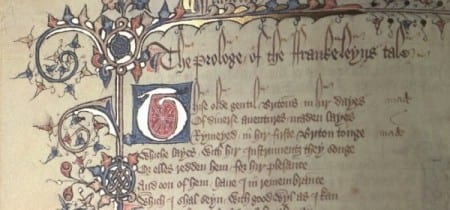What is a lai? The Franklin explains…
By uclfecd, on 15 August 2013

The Franklin’s Prologue in the Ellesmere Manuscript.
San Marino, California, Huntington Library, MS EL 27 C 9, fol. 123v (early fifteenth century).
In the Canterbury Tales, Chaucer’s fictionalised account of a storytelling competition between a group of pilgrims written in the late fourteenth century, the Franklin begins his tale with a few lines which leave his listeners in no doubt as to the type of story they are about to hear:
Thise olde gentil Britouns in hir dayes
Of diverse aventures maden layes,
Rymeyed in hir firste Briton tonge,
Whiche layes with hir instrumentz they songe[The noble Bretons of long-ago times composed lais about many different adventures, putting them into rhyme in their own Breton language; they sang these lais accompanied by their instruments]
Here the Franklin quickly name-checks the essential features he feels one might expect lais to have: they were composed in a mistily obscure far-off past by the ancient Bretons, in the Breton language; they recount stories of adventures; and they are set to music. These four lines neatly encapsulate the popular perception of the Breton lai in Chaucer’s day, and suggest that the genre must have been a familiar one; with just a few formulaic phrases, the Franklin can clearly evoke the type of fictional universe in which his tale is set (similar to beginning a fairy tale with ‘Once upon a time’). He then launches into his story proper, that of the Breton lady Dorigen and the rash promise she makes to a suitor, secure in the knowledge that his audience will be in the proper frame of mind.
How did the tales of the ‘olde gentil Britouns’, composed in ‘hir firste Briton tonge’, end up in Chaucer’s Canterbury Tales? To find out, continue reading…
 Close
Close




